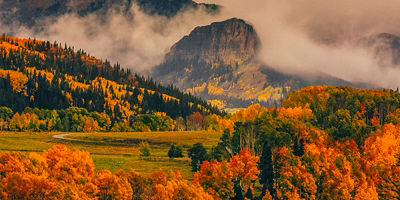
With its singular collection of attractions, Yellowstone National Park—which sits primarily in the northwest corner of Wyoming, with slivers in Montana and Idaho—is like no other place on the planet. Built on an ever-changing landscape that bubbles, bursts, and blows sky-high, the park would be worth a visit simply for its unique geysers, hot springs, and steam vents.
But there’s so much more than hydrothermal fireworks to see here: For one, it’s a nearly intact ecosystem where grizzly bears, black bears, wolves, bison and elk roam free. Its mountain peaks reach above 11,000 feet, and a couple of enormous waterfalls tumble hundreds of feet into a polychrome canyon. A vast high-elevation lake anchors one corner of the park, while legendary trout rivers crisscross its lands.
In a park this size—you could fit Rhode Island and Delaware inside its borders—it’s impossible to see everything in one trip. But don’t let that intimidate you: Visiting even a slice of Yellowstone makes for an unforgettable adventure. Just don’t be surprised if you find yourself drawn back again and again, ready to explore yet another aspect of this phenomenal park.
The Science Behind Yellowstone’s Geysers
Yellowstone National Park boasts more than 10,000 thermal features, including the highest concentration of geysers in the world in the Old Faithful area. They include the famous geysers and multicolored hot springs, but also fumaroles (steam vents) and bubbling mud pots. All the features owe their existence to underground heat from the immense supervolcano located under the landscape. As precipitation trickles back underground, it heats up, builds pressure, and rises back to the surface in a number of ways. If there’s little obstructing its path, the hot water seeps up as a hot spring; if the superheated water meets resistance in the rock as it rises, it will stop until pressure builds high enough to cause a spectacular geyser eruption.
Supervolcano, you say? Yes, Yellowstone sits on top of an enormous volcano, which has periodically produced huge eruptions throughout history, the most recent one 640,000 years ago. You can see the rim of the caldera (the bowl-shaped depression formed by the last eruption) in several places throughout the park.
Yellowstone’s Wondrous Wildlife
The animal life in the park’s wide-open plains and mountain peaks looks a whole lot like it did centuries ago. The large, exciting animals like grizzlies, black bears, bison, wolves, moose, Canada lynx, bighorn sheep, and elk attract many visitors. But the park’s ecosystem includes many other species, from badgers and golden eagles to river otters, beavers, and tiger salamanders. What’s more, your chances of seeing at least some of your life-list wildlife are very good here—there’s nothing quite like glimpsing your first bear or wolf in the wild.
The Human History of Yellowstone
The original human inhabitants of what’s now Yellowstone were members of the Tukudika people, a band of the Mountain Shoshone. Tukudika translates to “eaters of the mountain sheep,” as bighorn sheep provided their main meat source. Skilled hunters, the Tukudika made arrowheads from obsidian they obtained in the park and moved between higher and lower elevations with the seasons. Today, 27 other Indigenous tribes have historic ties to Yellowstone and its resources.
White explorers first saw the area in the early 1800s. Several expeditions explored Yellowstone’s wonders over the next few decades; their reports and pictures helped lead to the creation of Yellowstone National Park in 1872—the country’s first.
Visiting the National Park
A trip to Yellowstone has changed a lot from the earliest days of tourism, when visitors saw the sights on horseback or in stagecoaches. Today, paved roads, restaurants, hotels, and visitor centers provide a touch of civilization, and the park has become more and more popular: This past August was Yellowstone’s busiest ever, with 921,844 visits, and annual visitation tops 4 million. But don’t be fooled. A vast wilderness awaits when you step off the beaten path, granting adventurous travelers a peek back in time to Yellowstone’s wild heart.
A car is essential to experiencing Yellowstone, as distances are lengthy and public transportation unavailable (unless you count guided tour buses). The park’s main road forms a figure-eight shape that connects the major attractions, with spurs leading to the five entrances and their gateway towns. You’d need weeks to really see it all, so the best bet for an average-sized vacation is to pick a portion of the park to explore in depth. Alternatively, you can attempt a whirlwind greatest-hits tour, but be prepared to spend a lot of time driving (and looking for parking) if you go this route.






















